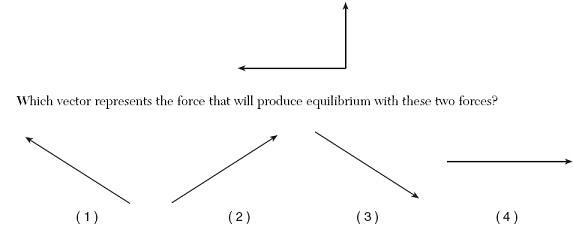Multiple Choice
Identify the
choice that best completes the statement or answers the question.
|
|
|
1.
|
The diagram below
represents two concurrent forces.

|
|
|
2.
|
The speed of an object undergoing constant
acceleration increases from 8.0 meters per second to 16.0 meters per second in 10 seconds. How far
does the object travel during the 10 seconds?
a. | 3.6 x 102 m | c. | 1.6 x 102 m | b. | 8.0 x
101 m | d. | 1.2 x 102
m |
|
|
|
3.
|
Approximately how much time does it take light to
travel from the Sun to Earth?
a. | 4.50 x 1019 s | c. | 1.28 x 100 s | b. | 2.00 x
10–3 s | d. | 5.00 x 102
s |
|
|
|
4.
|
If light from the sun takes 5.5 hours to reach
Pluto (the planet not the dog!) how far is that planet from the sun?
a. | 4.6x105 km | c. | 1.5x104 km | b. | 5.9x109
km | d. | 9.9x107 km |
|
|
|
5.
|
The mass of a 1 gram paper clip is:
a. | 1 x 10-6 kg | c. | 1 x 10-3 kg | b. | 1 x 106
kg | d. | 1 x 103 kg |
|
|
|
6.
|
What is another form of units for N
a. | kg·m2/s2 | c. | kg·m2/s | b. | kg·s2/m2 | d. | kg·m/s2 |
|
|
|
7.
|
A rock falls from rest a vertical distance of 0.72
meter to the surface of a planet in 0.63 second. The magnitude of the acceleration due to gravity on
the planet is:
a. | 2.3 m/s2 | c. | 3.6 m/s2 | b. | 9.8
m/s2 | d. | 1.1
m/s2 |
|
|
|
8.
|
The speedometer in a car does not measure the
car’s velocity because velocity is
a. | vector quantity and has a direction associated with
it | b. | vector quantity and does not have a direction associated
with it | c. | scalar quantity and has a direction associated with
it | d. | scalar quantity and does not have a direction associated
with it |
|
|
|
9.
|
An 80-kilogram skier slides on waxed skis along a
horizontal surface of snow at constant velocity while pushing with his poles. What is the horizontal
component of the force pushing him forward?
a. | 0.05 N | c. | 40 N | b. | 0.4 N | d. | 4 N |
|
|
|
10.
|
A carpenter hits a nail with a hammer. Compared to
the magnitude of the force the hammer exerts on the nail, the magnitude of the force the nail exerts
on the hammer during contact is:
|
|
|
11.
|
Who developed the three laws of
motion?
a. | Sir Isaac Newton | c. | Marie
Currie | b. | Dr. Sheldon Cooper | d. | Galileo |
|